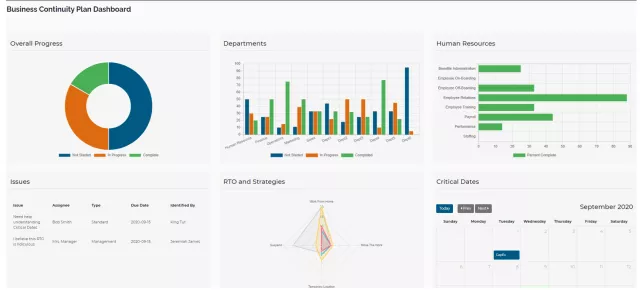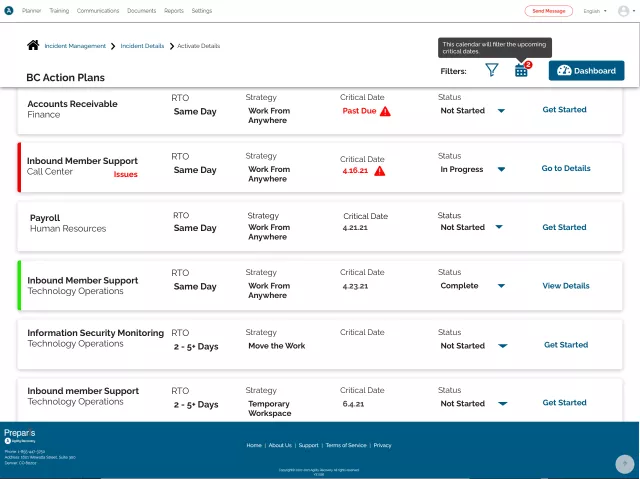Averting Reputational Risk with Incident Management Software

The way organizations function on a day-to-day basis is constantly changing, but those changes accelerated greatly since the onset of the coronavirus pandemic in March 2020. Technology and the ability to work remotely have altered internal roles and functions at organizations, and the way they operate is shifting into the digital space, so why not take advantage of business continuity and incident management software?
Data and document management, communication, collaboration, and client relationship management have all been embraced and adopted through technology, so why should managing business continuity be any different?
It has always been critical to keep up with the times and give business continuity more attention than a folder collecting dust on a shelf. With all the change comes new disruptive situations that require innovative practice and understanding.
Business continuity management is more than just compliance – it's the foundation of a company’s reputation and stability. Sixty-seven percent of professionals reported that the most successful outcome of employing resilience capabilities is the preservation of reputation and community trust. Let’s dive into how incident management and business continuity software are critical to risk management.
Business continuity software helps adjust to organizational changes
As organizations evolve and restructure, data management in most advanced software enables plans to be relocated to reflect changes in business structure or business location. Software like Preparis Planner, RecoveryPlanner, and Incident Manager hosts all relevant and important documents related to your company's business continuity processes under one roof - then makes it a breeze to implement your plan. Should a BIA or any other important document be updated, anyone can access the changes anywhere with the right permissions. Besides that, with task delegation and progress tracking your business continuity program will always hit its deadlines.
Streamlined planning and training
The risks caused by recent events have renewed the industry focus on exposures associated with pandemics, weather-related disruptions, and supply chain resilience. This is where the planning and training components of software come into play. Such functionality ensures that employees know exactly how to respond in an emergency, and management can make sure everything is in place to navigate successfully through the next incident.
The planning part of the software must be capable of supporting the continuous revision of requirements and the dissemination of new guidelines as the business evolves, new threats emerge, and new compliance standards are implemented. Organizations taking advantage of business continuity software will find it more efficient to revise planning requirements and implement them across the enterprise than those companies that use templates for word processing or spreadsheet programs.
The software supports the development of business continuity metrics
As your company goes through the inevitable changes, the software produces complex reports that summarize business continuity information. Needless to say, the leadership team that’s interested in building a resilient business requires an enterprise-level view of the current state of preparedness to determine program direction.
Manually gathering data from multiple documents to develop metrics is an arduous task. If there’s no platform, the generation of metrics won’t be frequent enough to provide value. Besides, if metrics data must be compiled manually, there is a much higher risk of error. Strategy development can become hindered if there’s no confidence in the accuracy of data and its ability to speak on behalf of the entire organization. Management may be reluctant or unwilling to act on the information.
As business continuity tools promote summary reporting, the leadership team can further change the organizational culture by acting on the data gathered and addressing exposures. If the change has been the result of the data insights, a person responsible for business continuity planning will see the direct value of their work and view the effort to create a resilient culture as sustained.
Hit the ground running with the right business continuity software
You’ve built your business continuity plan using a program – now what? Adding on software like Preparis Incident Manager allows you to put your plan into action, giving you the tools necessary to work your plan. Your team will know what to focus on first when faced with any business interruption or testing scenario.
The leadership team can quickly delegate tasks to their owners, and team members can easily see where they need to focus. Leadership can also leverage bi-directional one-touch communication capabilities to help assign tasks, get updates, and check in on their teams.
The right software will also automate status updates and update dashboards in real time to reflect progress or potential gaps. You also have the ability to make fact-based decisions as a team in live physical or virtual war rooms.
Business continuity software drives program commitment, innovation, and advancement
Recent business continuity standards and regulations like FFEIC’s recent updates regarding stressing the value of resilience speak to the need to move beyond plan creation to the establishment of an organizational culture of preparedness and resilience. An organization with mature business continuity has an embedded understanding of risk awareness. Such a company also views its continuity plan as an integrated component of routine processes. It is much easier to instill a sense of ownership if management recognizes a serious investment of resources in support of resilience.
The argument against business continuity software, such as high cost and an intricate setup process, is at the foundation of creating a resilient culture.
In Conclusion
Organizations that use business continuity software will reap a lot more rewards, giving them headway that will only increase as business continuity makes its strides into the future. The evolving demands on continuity programs are too prominent to be managed in an old-fashioned way.
The business continuity maturity gap between organizations employing continuity software and those that are not will only grow as software capabilities advance and as new threats become known.




